Emerging Connections
Virtual Coaching PLCs In and Out of School
Connected Science Learning January–February 2021 (Volume 3, Issue 1)
By Kate Cook, Hannah Lakin, Sue Allen, Scott Byrd, Brittney Nickerson, and Kate Kastelein
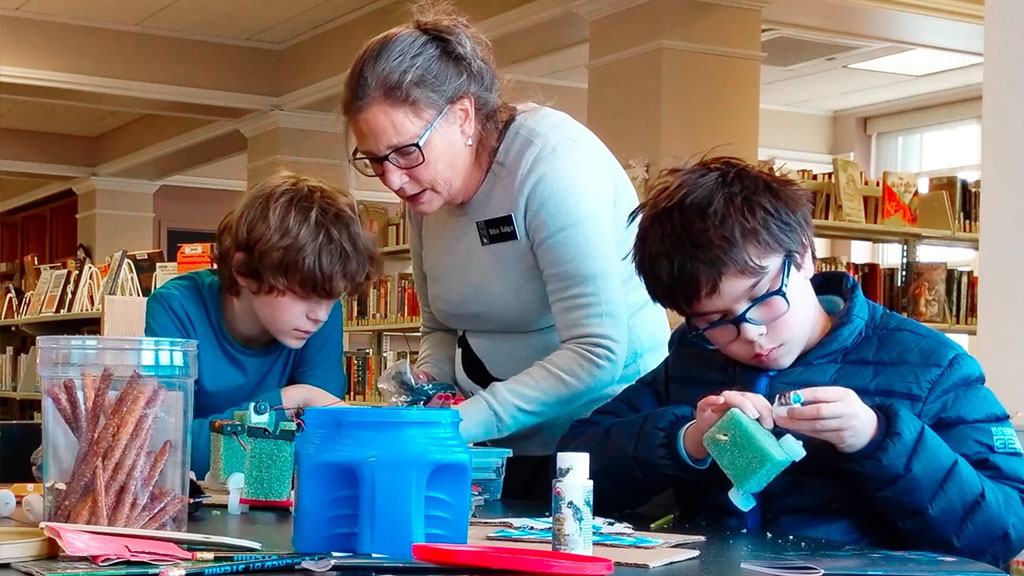
Instructional coaching and professional learning communities (PLCs) are both productive activities for advancing the practice of STEM educators. Both forms of professional learning are best done in collegial peer groups or with independent, non-evaluative coaches. In small educational settings—such as out-of-school time (OST) programs with limited front-line staff or rural schools with limited numbers of teachers in each grade level or subject area—innovative strategies for engaging in professional learning are needed. One approach is to engage educators virtually with peers across multiple organizations or schools.
In Part 1 of this article, we describe a Virtual Coaching PLC approach designed with and for out-of-school educators that blends instructional coaching with PLCs in a virtual environment. Our approach is the cornerstone of the Afterschool Coaching for Reflective Educators in STEM (ACRES) project. Informed by the success of mostly in-school PLCs and instructional coaching, we designed our approach for afterschool providers and library staff—educators who are often isolated in their work and have limited time to engage in professional learning. Lessons learned from our Virtual Coaching PLC work with out-of-school educators are having important, productive impacts on our work with in-school educators. In Part 2, we illustrate the types of adaptations we make when using the approach with in-school educators. Finally, in Part 3, we explore implications for continuing to build upon the mutually strengthening nature of this out-of-school and in-school use of Virtual Coaching PLCs.
Part 1: The ACRES Approach to Virtual Coaching PLCs
Context
PLCs are an increasingly popular approach to professional learning for in-school teachers and administrators. Typically, PLC groups consist of 10–15 professionals engaged in collaborative learning to improve practice, problem solve, learn a new skill, and contribute new knowledge or original products (McKenzie 2014; Vance et al. 2016). Despite the many advantages of PLCs, it can be difficult to engage educators in continued involvement in PLCs due to time and financial barriers (McConnell et al. 2013). Educators working in OST settings often have more restrictive budgets and schedules compared with formal educators, and many OST organizations may not be large enough or centralized enough to easily host and facilitate PLCs. As such, PLCs for out-of-school educators have been slow to take hold, and with a few notable exceptions (e.g., Martin et al. 2019), out-of-school educators have limited opportunities to participate in PLCs to improve practice (Vance et al. 2016).
A second extremely effective approach to improving STEM educator practice for in-school settings is instructional coaching. Instructional coaching often occurs in a coach/educator pairing. Together, the educator and the coach work toward collaboratively identified goals, which may include improving a particular instructional practice, learning a new instructional skill, or improving certain student outcomes (Desimone and Pak 2017; Gibbons and Cobb 2017). While instructional coaching is a promising approach to professional learning, the process is time intensive and requires a designated coach with deep contextual knowledge. Once again, it can be extremely difficult to engage out-of-school educators in instructional coaching cycles due to limited funding, limited time, and fast-paced, ever-changing educational contexts. Just as PLCs have been slow to take hold in OST contexts due to organizational limitations, instructional coaching has been largely limited to formal educational contexts.
Physical distance from professional learning events further exacerbates financial and time constraints, particularly for geographically isolated educators and programs, often resulting in unequal access to professional learning opportunities. Since its inception, the ACRES program has sought to address these challenges by making our professional learning completely virtual for all educators. We have developed and continue to refine many effective strategies and approaches to engaging educators in interactive and collaborative professional learning (see "Beyond the Webinar: Dynamic Online STEM Professional Development"; Brasili and Allen 2019). As a result of our focused efforts to develop fully virtual, interactive, and collaborative PLCs focused on instructional coaching, we were exceptionally well positioned to quickly respond to virtual professional learning needs and strategies resulting from the COVID-19 shutdowns and continued restrictions.
Our Approach
The ACRES project was originally designed to capitalize on the successes of PLCs and instructional coaching in formal educational settings and adapt both strategies in ways that make them accessible and productive for OST educators, particularly afterschool program staff and librarians. The ACRES approach for professional learning draws key components from PLCs and instructional coaching, effectively blending the two such that participants engage in coaching cycles as part of a collegial group. We refer to this type of professional learning as Virtual Coaching PLCs (see Figure 1). In these PLCs, educators convene in small peer-based cohorts with the goal of improving practice through new skill acquisition and peer-based coaching. Virtual Coaching PLCs are facilitated by non-evaluative facilitators with expertise in developing meaningful, productive communities of practice in the targeted instructional skills of the cohort.
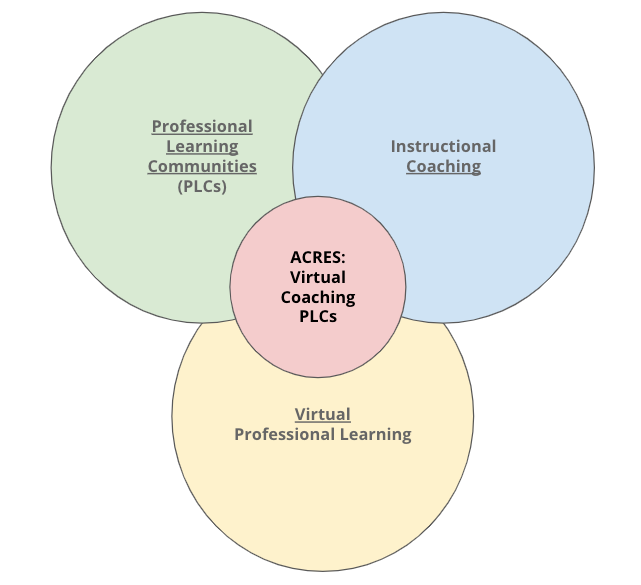
The essential structure of the ACRES approach consists of cycles in which an experienced coach introduces a new skill and participants have time to practice it. They then share a video of themselves using it in their interactions with youth, with accompanying discussion and suggestions from the coach and their peers (see Table 1).
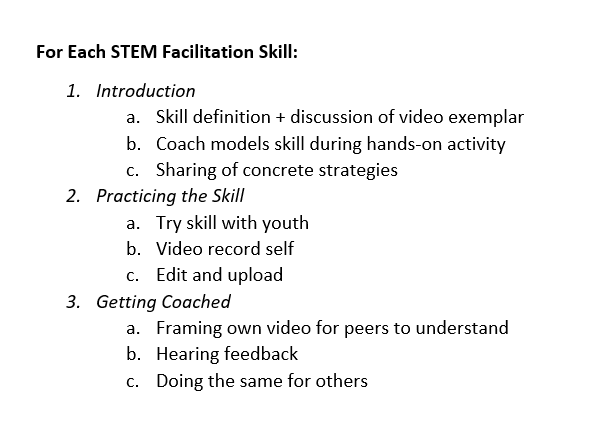
A more detailed description of the structure of the PD follows:
- Setup: Our virtual coaching PLCs are made up of approximately 4–10 educators working in various locations (most often rural) across the United States. We have engaged groups as large as 25 but have found these groups often become unwieldy, which minimizes productive discourse. Groups smaller than 4 are too small to generate substantive dialogue. While some virtual coaching PLCs will take part as a team from one OST program or network, we also have groups composed of educators who were previously strangers. The educators in each PLC provide programming from preK through 12th grade with a majority working with youth in grades 3–5. Materials needed to fully participate include a computer with a webcam, an internet connection, a camera (usually a smartphone) to record their practice, and common household materials for hands-on STEM activities (e.g., cotton balls, tape, scissors).
- Introduction: The skill introduction happens during a group workshop, typically about two hours long. (a) The coach begins by introducing the skill (e.g., “asking purposeful questions” or “giving youth voice and choice”). The group then watches a video of an afterschool educator using the skill effectively (see first photo below), and the coach facilitates a microanalysis of how the skill was used and what response it elicited from the youth. The video analysis helps educators both recognize the skill in action and look for evidence of its impact on the youth. (b) Participants virtually engage in a hands-on activity (e.g., designing a water filter) while the coach demonstrates the skill in context, followed by group discussion (see second photo below). (c) The coach distributes a reference document with concrete strategies for implementing the skill (e.g., a page of specific question-starters). Participants then try out the skill while doing a short hands-on activity.
- Practicing the skill: (a) The educators have two to three weeks to practice the new skill in their programs and with their youth. They can choose to practice the skill in either the context of the same STEM activity demonstrated by the coach or any other hands-on activity of their choosing. (b) Using a smartphone, tablet, or other recording device available to them, educators video record themselves practicing the skill with youth. (Prior to filming, youth and their parents are provided with a courtesy letter informing them that youth may be videotaped while engaging in STEM activities for the purposes of educator professional learning. The letter states that a small number of other educators may view the recording during a coaching session and that following the coaching session, the videotape will be destroyed.) (c) If the video is longer than a few minutes, they edit it down to two or three minutes and upload to a private shared space, such as FlipGrid or Vimeo, where others in the group can view it, but it is not publicly available (since it includes identifiable recordings of minors).
- Getting coached: (a) During one to two group sessions with the coach (each typically 60–90 minutes), the educator frames the video so that others can understand what they are seeing (describing the youth, the activity, the reasons for selecting this part, and any specific thoughts they have about their experience of trying the skill). (b) After watching the video, the peers and the coach take turns offering feedback to the video presenter in the structured form of “one strength” and “one opportunity to consider going forward.” (c) Educators take turns presenting their videos and offering feedback, so that each person gets multiple opportunities to think about how the skill can be used and adapted to different settings and activities (see third photo below).
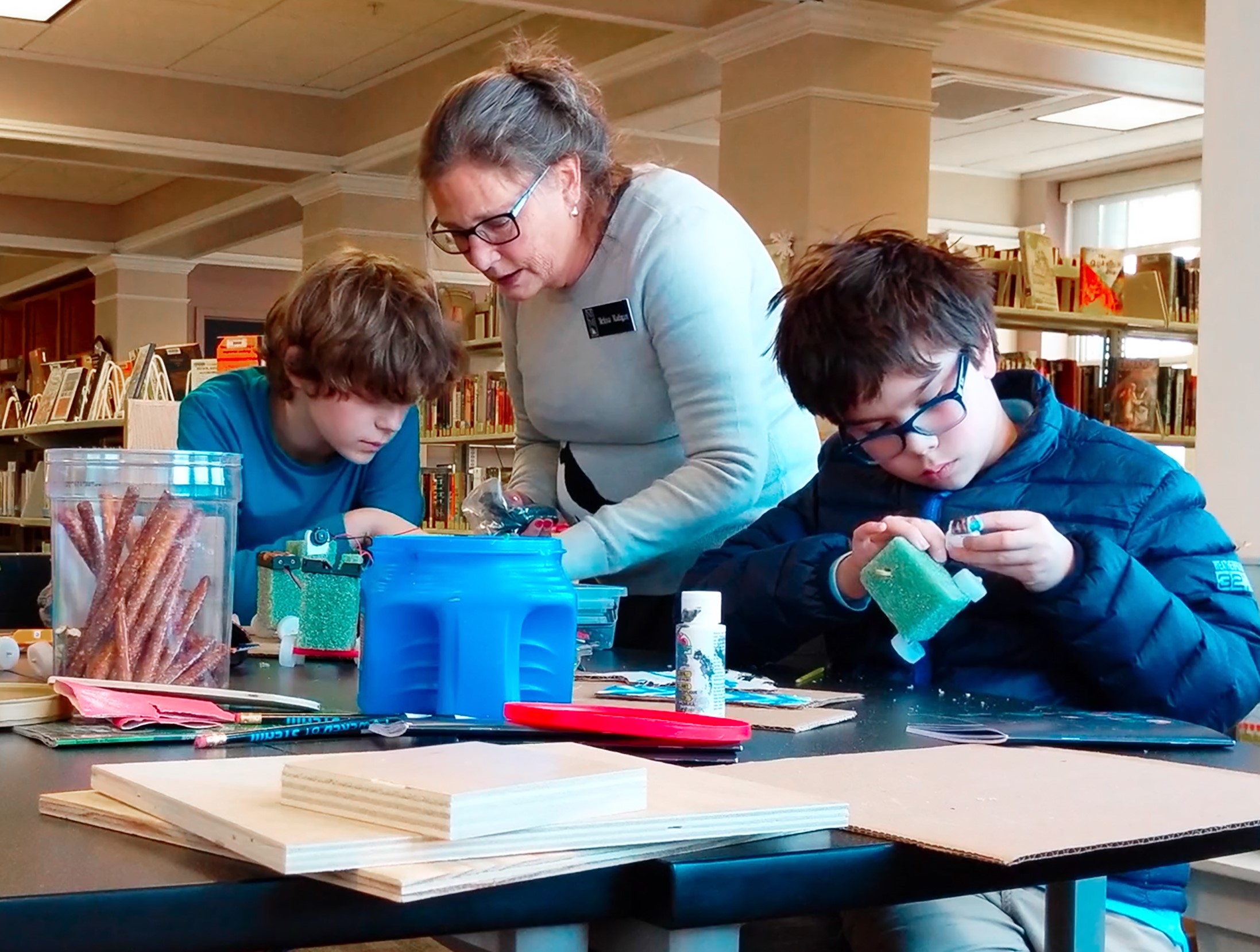
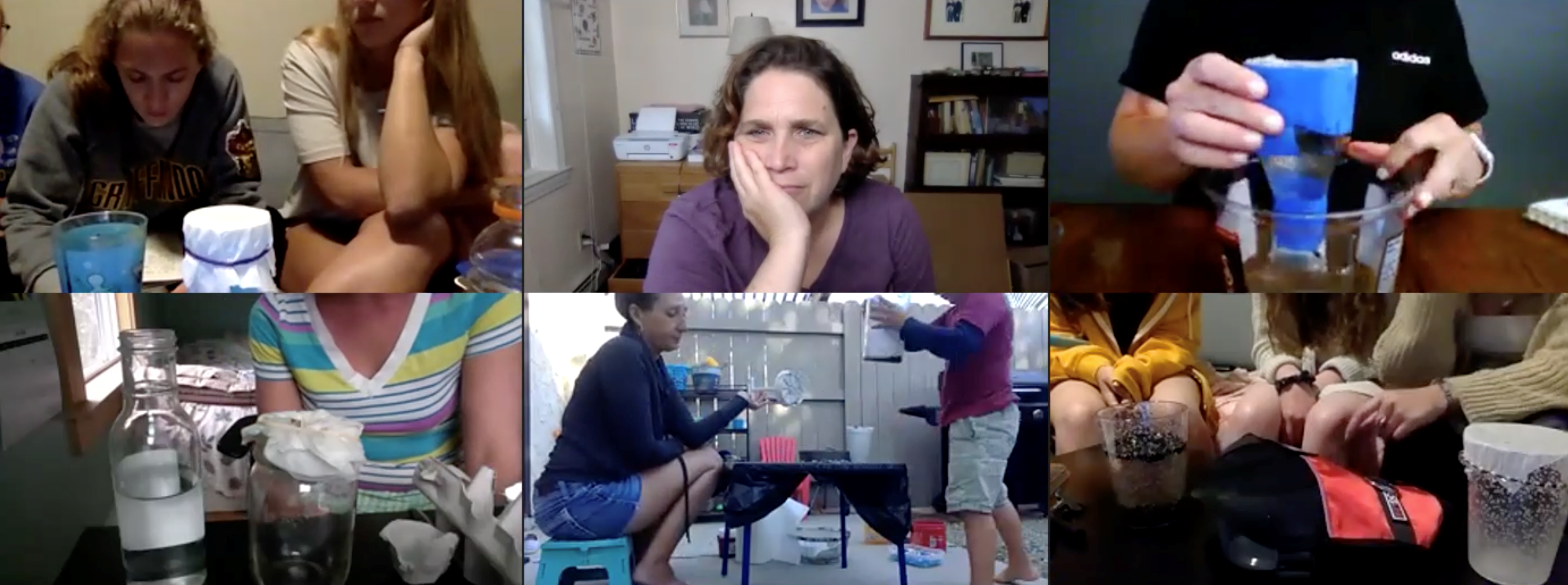
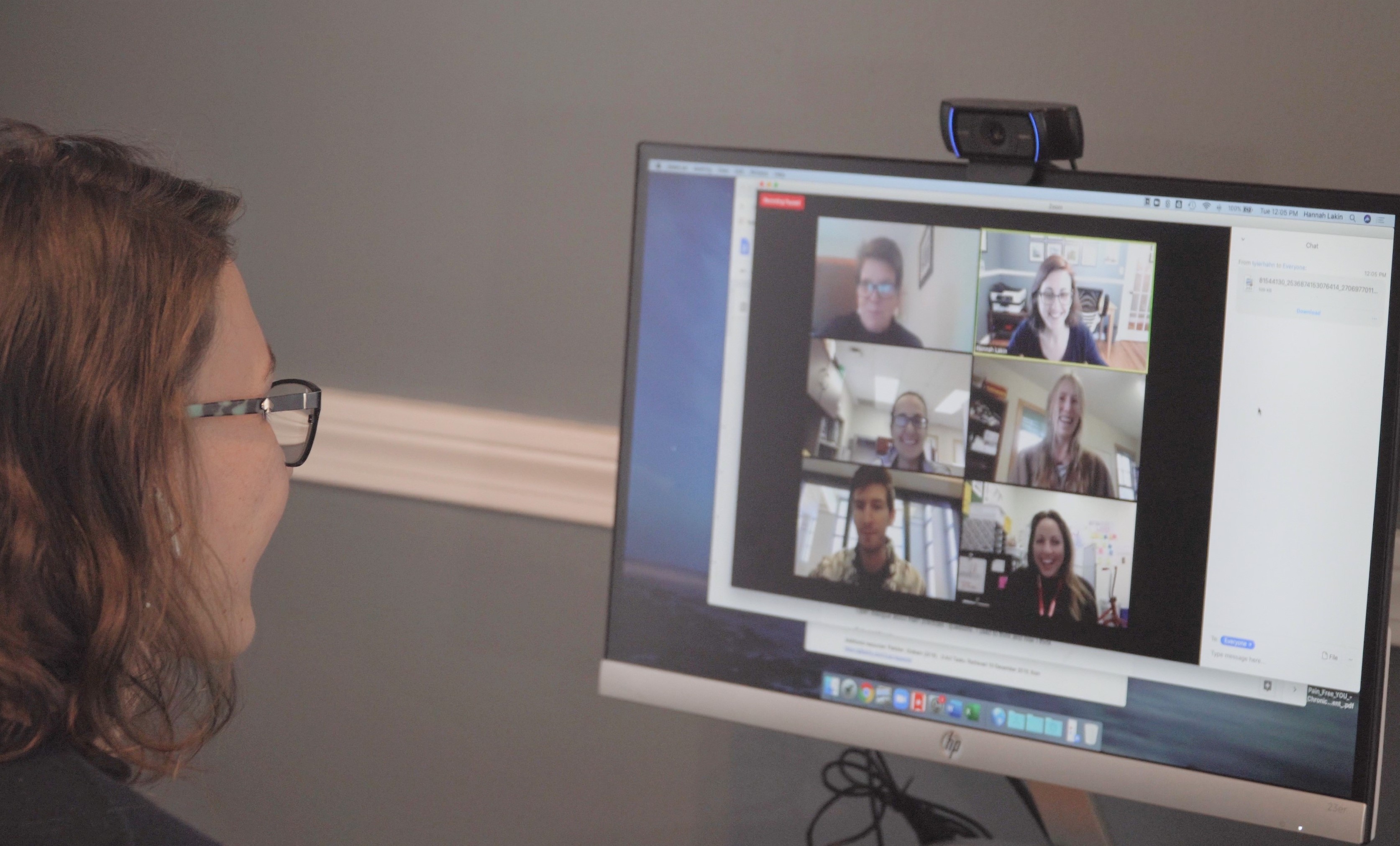
Our professional learning was designed to focus on a subset of skills that (1) have been shown to be fundamental to strong STEM pedagogy in general, (2) align with the tenets of OST programs in particular and their focus on youth development, and (3) can be applied across a very broad set of activities and youth characteristics. The set of six skills includes: asking purposeful questions, modeling the engineering process, modeling science processes, giving youth voice and choice, developing STEM identity and making career connections, and exploring youth understanding (See “Formative Assessment of STEM Activities in Afterschool and Summer Programs”; Sneider and Allen 2019).
Promising Evidence Supporting Our Approach
Our initial three-year investigation into using Virtual Coaching PLCs with OST educators has yielded very promising findings. To gain better insight into the ACRES Virtual Coaching PLC model, we gathered data from pre- and post-surveys and interviews with over 40 cohorts. Immediately following participation in an ACRES Virtual Coaching PLC, frontline educators’ self-reported confidence increased significantly in relation to the target facilitation skill as well as other ACRES-related capabilities. For example, educators’ confidence in their “ability to ask youth good questions as they work on STEM activities” increased from 3.03 to 3.59 on a 5-point scale (with 0 = not confident at all, 4 = extremely confident, n = 187, p < .001, paired sample t-test).
Further, before and after the course, educators viewed an animated video of a hypothetical afterschool STEM program and provided constructive feedback to the facilitator. Pretest versus posttest comparisons showed a significant increase in educators’ identifications of effective use of the target skill—in this case, how to ask youth purposeful questions (pre 4.32 to post 5.44, p < .01), especially the more nuanced subskill of following up with youth to clarify their thinking (pre 1.00 to post 1.46, p < .001).
Another encouraging finding has been that the positive outcomes of participation in an ACRES virtual coaching PLC stay with educators long after participation in an ACRES cohort. In follow-up interviews six months to two years after participating in the Purposeful Questions module, 95% of educators who had taken the first module (only six hours long) could describe, in detail and with examples, how the ACRES experience had changed the way they work with youth and the way youth had responded to this change. For example, “I think they were resistant at first, but as I gave them more time, or probed with more questions, they definitely responded positively … I’ve learned to avoid one-word response questions, like yes or no … So those kids did definitely respond to that. It took some time on my part, to create that culture of like, explaining your thinking and probing deeper.”
Part 2: Using Virtual Coaching PLCs in In-School Settings
While the ACRES model was originally designed to adapt professional learning strategies used in formal education to OST settings, we are finding that our work is coming full circle. The Virtual Coaching PLC model that we developed is now positively influencing our work with in-school educators. Because many of our ACRES team members support educators in both the in-school and OST worlds, the approach used with OST educators began organically influencing our work with in-school educators. Over time, we slowly began incorporating pieces of the ACRES Virtual Coaching PLC model into our regular consulting work with in-school educators.
Our approach—designed to build community among OST educators and improve STEM facilitation skills—has benefited in-school educators who are also often isolated in their work. This includes educators teaching in remote or rural settings who are often the only teacher for a particular grade level or subject area and lack a built-in professional learning network. Broadly, we have noticed that several aspects of the Virtual Coaching PLC approach seem to be particularly influential in our work with in-school educators:
- Structure: Starting with experiencing a skill or instructional strategy, progressing to analyzing the skill or strategy in context, and culminating in practicing the skill with youth and receiving feedback on it from peers is a powerful structure for both OST and in-school educators.
- Scheduling: Shorter sessions scheduled over several weeks provides opportunities for educators to engage in frequent and ongoing professional learning that fits within their busy schedules for both OST and in-school educators.
- Situating Learning in Context: Situating professional learning within educators’ context by having educators practice skills or strategies in their own programs and bringing recordings back to the group for feedback allows for more personalized experiences.
Below, we expand on each of these aspects by providing contextualized examples of how we have translated the ACRES Virtual Coaching PLC approach back to in-school settings. Specifically, we showcase two professional learning experiences designed for in-school educators:
- Case A: High School Mathematics — A professional learning experience focused on “Asking Purposeful Questions” for high school mathematics teachers
- Case B: K–12 Science — A professional learning experience for K–12 educators focused on science storyline development designed for the Next Generation Science Standards (NGSS Lead States 2013)
Case A: High School Mathematics
The high school mathematics Virtual Coaching PLC had seven educators who made up one school’s math department. The opportunity to gather for an ongoing series was initiated by the school administration in partnership with teachers who were interested in reflecting on their practice. Teachers were also incentivized to participate with professional development contact hours necessary for licensure, as well as with compensation for their time. The whole group met three times with approximately three to four weeks between each session. To participate fully, members needed an internet connection, a computer with a webcam, and a camera (or phone with a camera) to record their practice. The costs of running the Virtual Coaching PLC included the time of the facilitating coach, the time of the educators, and any additional technology.
Structure
The high school mathematics cohort was structured in a similar way to the ACRES cohorts (see Table 2). Cohort members spent the first Virtual Coaching PLC session immersed in the mathematics facilitation skill of Posing Purposeful Questions, one of the key mathematics practices (National Council of Teachers of Mathematics 2014). Cohort members first learned the skill, then experienced a mathematical modeling activity from the perspective of a learner, and discussed the role of particular types of questions within the task. “Assessing questions” are questions that have students clarify their thinking and give the teacher more information about student understanding. For example, “Explain why you chose to organize your result this way.” Similarly, “advancing questions” are often used to propel students to think more deeply. For example, the question, “Does it always work that way?” might be used to help advance a student toward making generalizations based on repeated reasoning. Educators were then given a handout with concrete strategies and examples of Purposeful Questions that they could use in their high school mathematics classes. After the initial session, educators spent time practicing the skill, either by modifying their lesson plans or by trying the skill with the students. Educators uploaded either video recordings of themselves working with youth or revisions they had made to their own lesson plans. During the coaching session, educators shared their videos with peers and received feedback in the same way that ACRES PLCs do.
Scheduling
Informed by our work with OST educators, we scheduled only three cohort meetings, and each meeting lasted no more than two hours. Meetings were scheduled outside of the school day at a convenient time for educators, which allowed them to relax in their own homes and engage in professional learning as an ongoing process that fit within their busy schedules.
Situating Learning in Context
Just as ACRES participants film their own work with youth, participants in the high school mathematics professional learning focused on using the skill of Posing Purposeful Questions in their own contexts. This allowed teachers to work with timely and relevant lesson plans that had immediate impact on their classroom practice. For example, during the first coaching session, one teacher shared and received feedback on Artifact A, a task they had prepared for pre-calculus students (see Figure 2). The feedback focused on helping the teacher pose questions that were more purposeful. At the second coaching session, the teacher shared Artifact B, which represented a significant shift in posing purposeful questions, moving away from rote computational practice and toward student reasoning and discourse. These artifacts showcase the power of contextualizing professional learning within teachers’ classrooms. While the artifacts are on different topics (because the class was studying different topics), the educator was nevertheless able to progress in the targeted skill.
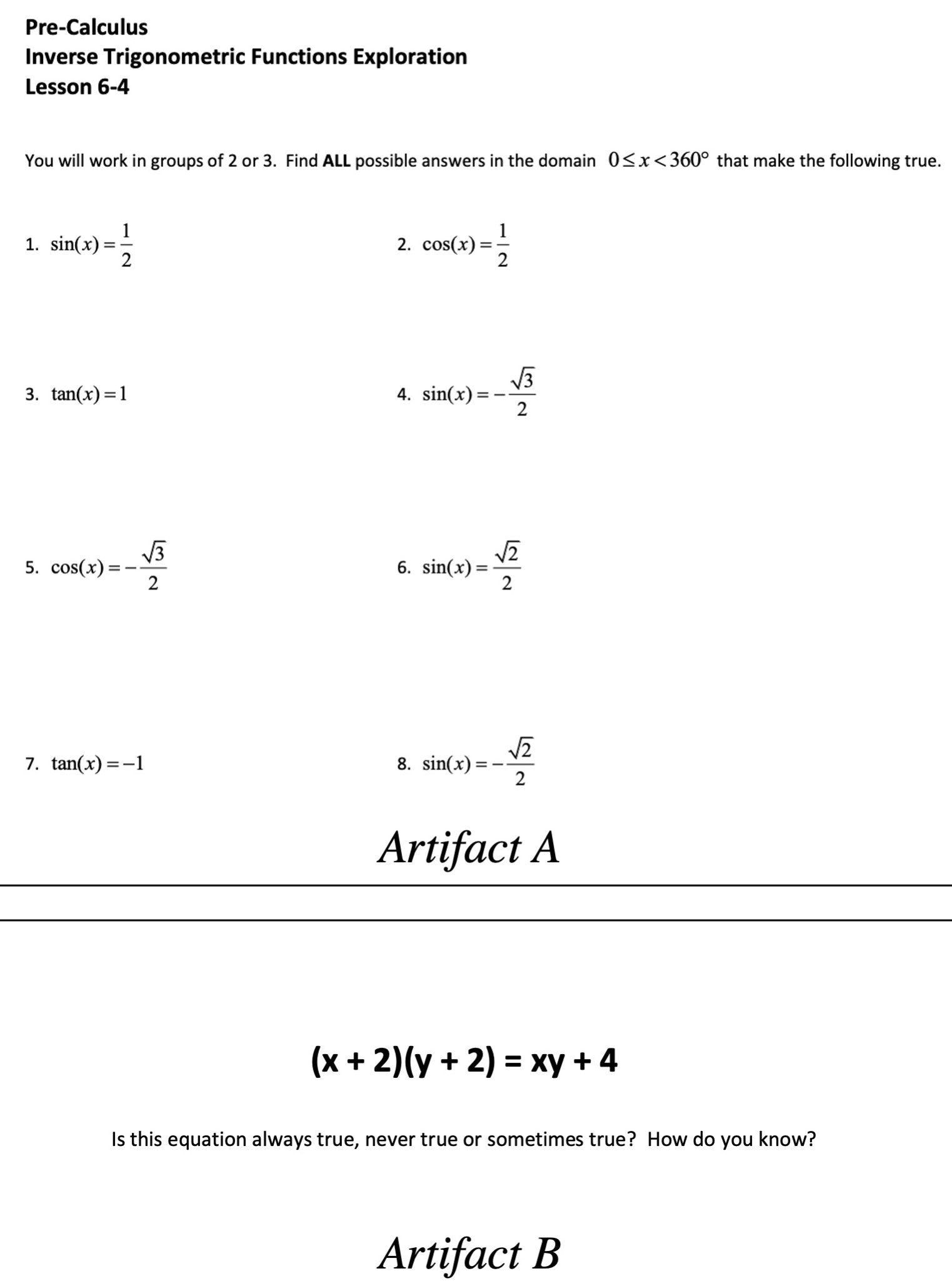
Case B: K–12 Science
The K–12 Science Virtual Coaching PLC included approximately 40 educators who were subdivided into three PLCs of 8–15 people each. The educators came from four different school districts and seven different schools, and taught grade levels ranging from second grade to twelfth grade. The opportunity to gather for an ongoing series was initiated by Maine Mathematics and Science Alliance. Districts, schools, or individual teachers could choose to opt in to the program. Teachers were also incentivized to participate with professional development contact hours necessary for licensure. The whole group met for a weeklong professional learning workshop and then met every other week for a semester in virtual PLCs. To participate fully, members needed an internet connection, a computer with a webcam, and access to a virtual platform such as Google Docs to share their work. The costs of running the Virtual Coaching PLC included the time of the facilitating coach, the time of the educators, and any additional technology.
Structure
The K–12 science professional learning structure was similarly informed by the ACRES cohort structure, though it deviated somewhat more from the original structure than the high school mathematics cohort (see Table 3). After engaging nearly 40 teachers in a weeklong professional learning workshop, the smaller Virtual Coaching PLCs cohorts met every other week for 12 weeks. Because many of the teachers were in the early stages of transitioning to the NGSS, we focused efforts on supporting teachers as they planned for NGSS-designed instruction. On odd weeks (Weeks 1, 3, 5, 7, 9, and 11), we focused on developing teachers’ knowledge of a particular instructional strategy (equivalent to the “facilitation skills” in the ACRES model). For instance, on Week 3, we focused on helping teachers understand how to plan using the Anchoring Phenomenon Routine. On even weeks (Weeks 2, 4, 6, 8, 10, and 12), teachers came prepared with their planning artifact. Planning artifacts were outlines, notes, or slides that teachers shared as evidence of their curricular planning. For instance, on Week 4, teachers came with an outline for their Anchoring Phenomenon lesson. During our Virtual Coaching PLC, cohort members examined each other’s planning artifact and provided feedback to one another.
Scheduling
Originally, we planned to schedule our ongoing sessions for two hours to mirror our work in ACRES. After consulting the teachers in our cohorts, however, we learned that two-hour blocks of time were even more challenging for teachers, given various after-school conflicts. As a result we limited meeting times to less than 90 minutes and held more of them over the course of several weeks. The shorter time frames were more manageable for participants and allowed us to focus on smaller, more digestible skills at each session. We scheduled one cohort after school and one in the evening (at 8 p.m.) to accommodate scheduling constraints that participants faced. This, too, mimicked the OST educators’ patterns of scheduling availability, and in some cases the teachers were running afterschool programs, so this was not surprising.
Situating Learning in Context
Inspired by the immediate relevance and applicability of the skills in the virtual coaching PLCs in ACRES, we designed the K–12 science experience to be immediately applicable for teachers, without requiring an initial grounding in theory. Unlike the ACRES model, however, the teachers planned units that they expected to teach at the end of the entire professional learning experience, without the opportunity to practice them between PLC meetings. One drawback was that they weren’t able to actually “test” any of their learning with youth to bring back to the group; however, benefits included teachers taking needed time to develop units in a supported way.
Part 3: Implications and Next Steps
We believe that there is great promise for both OST and in-school educators and professional learning facilitators to continue to reciprocally iterate on the ACRES Virtual Coaching PLC approach. From our experiences, we believe it is worthwhile to continue to use strategies that are productive for both in-school and OST educators. These strategies include
- structuring virtual sessions to include “skills” sessions followed by “coaching” sessions;
- scheduling ongoing professional learning in shorter, more manageable time frames; and
- situating professional learning in the educators’ immediate context.
To establish this approach as an effective and needed practice for in-school educators, additional evaluative work is needed to document the ongoing changes in teacher thinking. A design-based research approach, iterating between the OST and in-school approaches, may reveal mutually beneficial strategies leading to key outcomes.
Overall, we are motivated by the prospect of continuing to improve on the in-school and OST adaptations and modifications to the Virtual Coaching PLC approach and the ways that the two worlds can mutually inform one another. In our case, this means having professional learning providers straddle both worlds as a way of “seeing into” each context to inform the other.
Lastly, we were struck by the overlap between the instructional practices of effective STEM teachers (National Council of Teachers of Mathematics 2014; NGSS Lead States 2013) and the recommended facilitation practices of effective afterschool providers characterized in frameworks such as Click2SciencePD, Dimensions of Success and STEM PQA. Skills such as asking purposeful questions, following up to understand student thinking, ensuring equitable participation by all youth, making time for reflection, and emphasizing relevance and connection-making are highly transferable skills that will support educators to be more effective for both in- and out-of-school settings.
Acknowledgment
This material is based upon work supported by the National Science Foundation under Grant No. 1713134. Any opinions, findings, and conclusions or recommendations expressed in this material are those of the author(s) and do not necessarily reflect the views of the National Science Foundation.
Kate Cook (kcook@mmsa.org) and Hannah Lakin are STEM education specialists, Sue Allen is a senior research scientist, Scott Byrd is a researcher, and Brittney Nickerson and Kate Kastelein are research associates, all at the Maine Mathematics and Science Alliance in Augusta, Maine.
citation: Cook, K., H. Lakin, S. Allen, S. Byrd, B. Nickerson, and K. Kastelein. 2021. Virtual coaching PLCs in and out of school. Connected Science Learning 3 (1). https://www.nsta.org/connected-science-learning-january-february-2021/virtual-coaching-plcs-and-out-school
General Science Mathematics Professional Learning old STEM Informal Education


